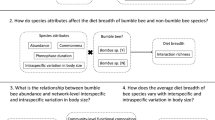Abstract
Long-term experimental systems with overlapping generations using a seed beetle, Callosobruchus chinensis, were maintained by providing 5 g of azuki beans (Vigna angularis) in two different renewal intervals: either 7 days or 10 days. The 7-day-renewal system (system 1) showed oscillatory dynamics with a constant periodic cycle of ca. 7 weeks. More stable population dynamics were seen in the 10-day-interval system (system 2). Short-term experiments showed that survivorship of adults increased with higher adult density, and that the survival rate of adults up to the age of 7 days was much higher than up to 10 days of age. In addition, the per capita production of hatched eggs by females which had survived for 7 days increased with increasing density experienced by the females. Females aged 10 days rarely laid eggs which hatched. We constructed a matrix population model based on either 1 week for system 1 or 10 days for system 2. The model included five stages in system 1: the hatched egg, the final instar larva, the pupa, the young adult and the old adult. Four stages were incorporated in the model for system 2: the young instar larva, the pupa, the young adult, and the old adult. Logistic-difference equations were applied to formulate both overcompensatory density dependence in the hatched-egg production by adults and undercompensatory response in the larval development up to the pupa. The survivorship of young adults to the old stage and the per capita hatched-egg productivity of the old females followed a linear regression against the young adult density. Inside-bean processes were adjusted to be equivalent in the two models, irrespective of the resource renewal intervals. The model predicted that system 1 would oscillate for a long time but that system 2 would rapidly converge to the equilibrium point. Multiplicative effects of both the delayed density dependence through interstage restraint effects and the overcompensatory density dependence in hatched-egg production generated various dynamic patterns ranging from a quickly disappearing damped oscillation to stable limit cycles in system 1. The relationship between resource renewal cycles and delayed density dependence was discussed based on these simulations.
Similar content being viewed by others
References
Bellows TSJr (1982a) Analytical model for laboratory populations of Callosobruchus chinensis and C. maculatus (Coleoptera, Bruchidae). J Anim Ecol 51:263–287
Bellows TSJr (1982b) Simulation models for laboratory populations of Callosobruchus chinensis and C. maculatus. J Anim Ecol 51:597–623
Caswell H (1989) Matrix Population Models. Sinauer, Sunderland, Mass
Desharnais RA, Liu L (1987) Stable demographic limit cycles in laboratory populations of Tribolium castaneum. J Anim Ecol 56:885–906
Gurney WSC, Nisbet RM (1985) Fluctuation periodicity, generation separation, and the expression of larval competition. Theor Popul Biol 28:150–180
Gurney WSC, Blyth SP, Nisbet RM (1980) Nicholson blowflies revisited. Nature 287:17–21
Gurney WSC, Nisbet RM, Lawton JH (1983) The systematic formulation of tractable single-species population models incorporating age-structure. J Anim Ecol 52:479–495
Fujii K (1968) Studies on interspecies competition between the azuki bean weevil and the southern cowpea weevil. III. Some characteristics of strains of two species. Res Popul Ecol 10:87–98
Fujii K (1983) Population dynamics in experimental resource-herbivore-carnivore system. Res Popul Ecol Suppl 3:155–165
Hassell, MP (1975) Density dependence in single-species populations. J Anim Ecol 44:283–295
Hassell MP (1978) The dynamics of arthropod predator-prey systems. Princeton University Press, Princeton
Hassell MP, Taylor VA, Reader PM (1989) The dynamics of laboratory populations of Callosobruchus chinensis and C. maculatus (Coleoptera: Bruchidae) in patchy environment. Res Popul Ecol 31:35–52
Leslie PH (1945) On the use of matrices in certain population mathematics. Biometrika 33:183–212
Leslie PH (1948) Some further notes on the use of matrices in population mathematics. Biometrika 35:213–245
Liu L, Cohen JE (1987) Equilibrium and local stability in a logistic matrix model for age-structured populations. J Math Biol 25:73–88
Nicholson AJ (1954) An outline of the dynamics of animal populations. Aust J Zool 2:9–65
May RM (1974) Biological populations with nonoverlapping generations: stable points, stable cycles, and chaos. Science 186:645–647
Peitgen H-O, Jurgens H, Saupe D (1992) Chaos and fractals: new frontiers of science. Springer, Berlin Heidelberg New York
Shimada M (1989) Systems analysis of density-dependent population processes in the azuki bean weevil, Callosobruchus chinensis. Ecol Res 4:145–156
Shimada M (1990) Comparison of the density-dependent population process between laboratory and wild strains of Callosobruchus chinensis. In: Fujii K, Johnson CD, Gatehouse AG, Yoshida T (eds) Bruchids and legumes: economics, ecology and coevolution. Kluwer, London, pp 361–371
Tuda M (1993) Density-dependence depends on scale: larval resource patch and whole population. Res Popul Ecol 35:261–271
Tuda M, Shimada M (1993) Population-level analysis on reduction in equilibrium population size of the azuki bean beetle. Res Popul Ecol 35:231–239
Utida S (1941a) Studies on experimental population of the azuki bean weevil, Callosobruchus chinensis (L.). I. The effect of population density on the progeny population. Mem Coll Agr Kyoto Imp Univ 48:1–30
Utida S (1941b) Studies on experimental population of the azuki bean weevil, Callosobruchus chinensis (L.). III. The effect of population density upon the mortalities of different stages of life cycle. Mem Coll Agr Kyoto Imp Univ 49:21–42
Author information
Authors and Affiliations
Rights and permissions
About this article
Cite this article
Shimada, M., Tuda, M. Delayed density dependence and oscillatory population dynamics in overlapping-generation systems of a seed beetle Callosobruchus chinensis: matrix population model. Oecologia 105, 116–125 (1996). https://doi.org/10.1007/BF00328799
Received:
Accepted:
Issue Date:
DOI: https://doi.org/10.1007/BF00328799




